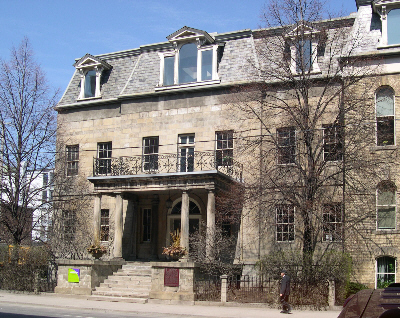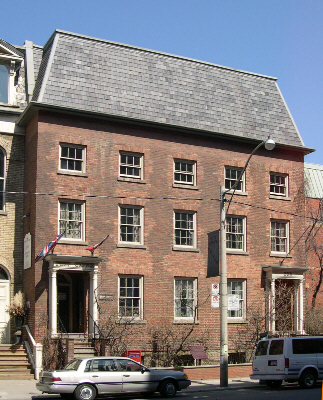At the north east corner of George Street and Adelaide Street (once Duke Street) one finds a block of buildings off considerable historic interest. On the corner stands the second building of the Bank of Upper Canada, the first chartered bank in the province. This building , which was the first in the province designed specifically for a bank, was completed in 1827. At the east end of this block of buildings, 260 Adelaide Street East is Toronto’s first post office. Built in 1833, it was then the York Post Office. A rare example of an early Canadian post office, it is characteristic of small public buildings from that period, that combine public offices with private residences. Number 258 between the bank and the post office is a later construction. In 1870 the Christian Brothers bought the two earlier buildings and constructed a three-storey building between them, adding a third floor with mansard roof in Second Empire style to all three. In the combined block they opened the De La Salle Institute, a Roman Catholic boys’ school which remained there until 1913, when they moved to larger quarters at Oaklands.
Bank of Upper Canada, 256 Adelaide Street East, 1827-1861
The plaque in front of the Bank of Upper Canada building states: “Chartered in 1821, The Bank of Upper Canada, was until its demise in 1866, one of British North America’s leading banks. It played a significant role in the development of Upper Canada, supplying currency protecting savings and making loans and aided Toronto’s rise as the commercial centre of the colony. This building opened in 1827, was the second home of the bank, Its design reflects the image of conservative opulence favoured by financial institutions of the time. The portico, designed by John G, Howard, a leading architect of the period, was added about 1844.”

Bank of Upper Canada
The Bank of Upper Canada was established in 1821 in York (Toronto, Ontario) under a charter granted by the Province of Upper Canada in 1819. It was the first chartered bank in the province, and quickly outgrew its first quarters in a converted store at the south-east corner of Frederick and King streets. In 1825, the bank purchased this corner lot from Sir William Campbell, whose house was just to the east at the top of Frederick Street. It was completed in 1827. Some say that the building was designed by Dr. W.W. Baldwin, but it may well have been Francis Hall (1792-1862), the building contractor for the bank. The classic portico on the bank, so similar to the columned porch on Baldwin’s house, was added in 1843, by John G. Howard, architect. The facade is of solid hewn stone and the interior woodwork was mahogany.
When Upper and Lower Canada were united in 1841 to form the Province of Canada, the Bank of Montreal was only the bank granted the right to issue copper tokens. It held this privilege until rioting in Montreal, following the passage of the Rebellion Losses Bill in 1849, resulted in the burning of the legislative buildings and the transfer of the capital to Toronto. Bank of Upper Canada was then given the right to issue tokens. It issued both copper tokens and paper notes. The bank failed in 1866 as a result of granting too many loans on poor security.
York Post Office, Toronto’s first post office 260 Adelaide Street East, east of Jarvis 1833
The plaque in front of this building states: “Originally all post offices in Upper Canada were owed by the postmasters in charge, who were imperial appointments. This building was constructed for postmaster James Scott Howard during 1833-1835 and functioned as the town’s post office until Howard’s dismissal in 1837. A typical example of a small public building of the time, combining public offices with a private residence, it survived as a rare example of an early Canadian post office. In 1876, it was incorporated into the present block of buildings. The mansard roof is a later addition.”

York Post Office
James Scott Howard, who was born in Ireland in 1798 and came to York in 1820, was appointed postmaster in 1828. In those times, postmasters had to provide the building and pay for staff, fuel, candles and stationery. Usually, their families also lived there. In April 1833 Howard bought the land from the Bank of Upper Canada, and built a three-storey red brick Georgian style house for himself and the post office, which had a separate entrance at the west end. When York became Toronto the next year, it was the city’s first and only post office. During the Rebellion of 1837, Howard was unjustly accused of disloyalty, and was dismissed in 1838. He sold the building to Hudson Murray, who lived there for many years.
De La Salle Institute
In 1870 the Christian Brothers bought the bank building, and in 1874 the post office building. They added a three-storey addition with a mansard roof between them, which was extended over the earlier buildings. In the combined block they opened the De La Salle Institute, a Roman Catholic boys’ school, and remained there until 1913. See Oaklands. During the Great War, it was a Royal Flying Corps recruiting centre. See also Early Airfields. Later it passed to Christie, Brown and Company and the United Farmers’ Co-Operative Co. When the complex was sold in 1956, the structure began to decay. It was empty for some years while waiting for demolition, and nearly burned down. In 1978, this complex was declared a National Historic Site. The building was bought by lawyer-historian Sheldon Godfrey and his wife Judith, who meticulously restored it. In her careful research of records Judith made the important discovery that the east end was Toronto’s first post office, and is believed to be the oldest surviving post office in Canada.
Most of this information came from “Original Toronto.”
